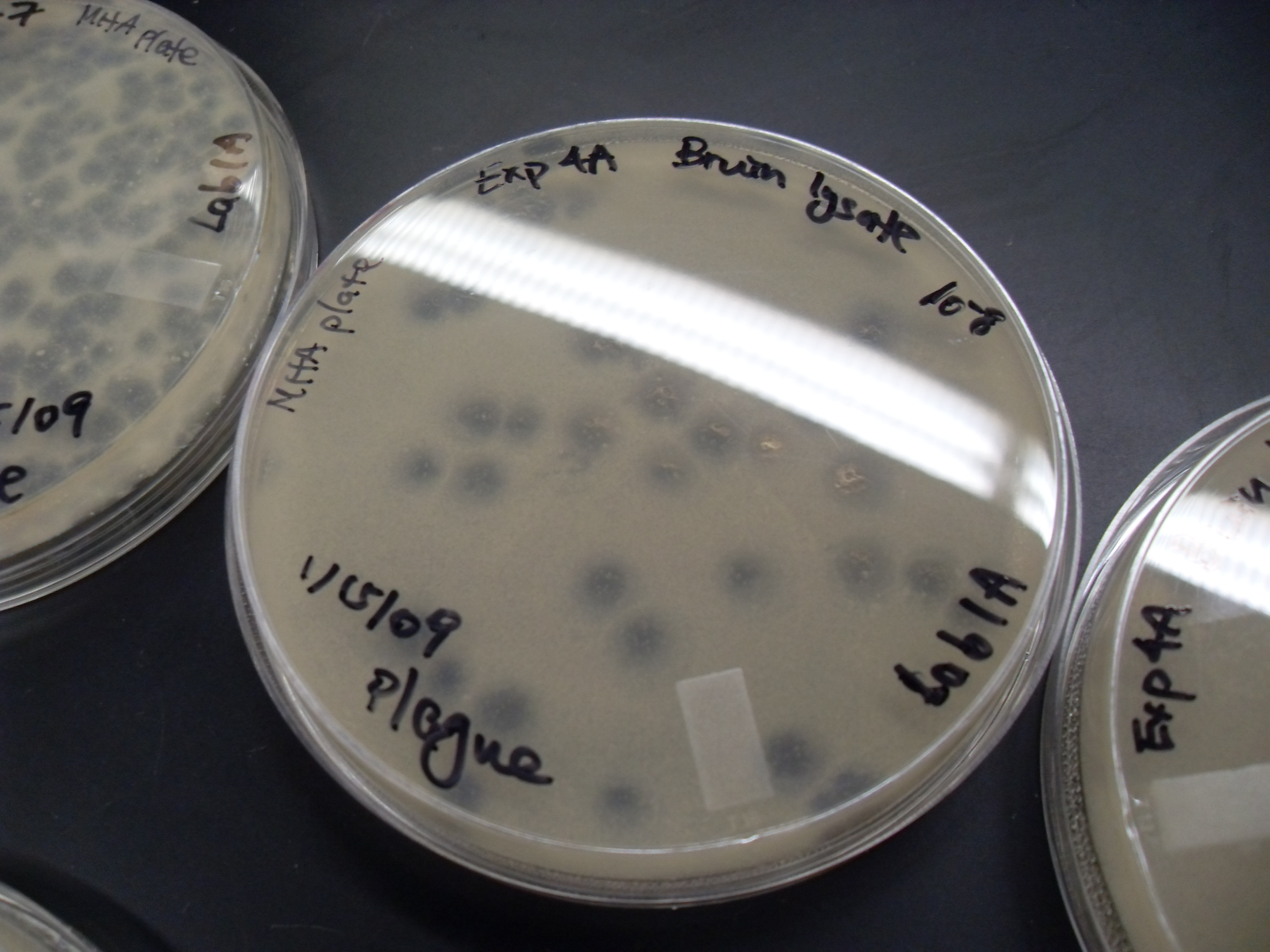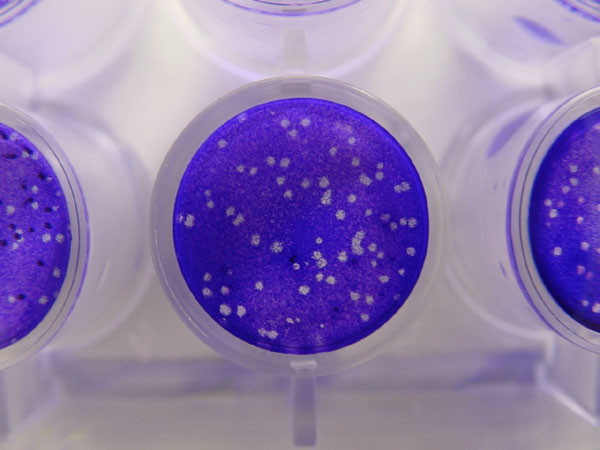|
Plaque Forming Unit
A plaque-forming unit (PFU) is a measure used in virology to describe the number of virus particles capable of forming plaques per unit volume. It is a proxy measurement rather than a measurement of the absolute quantity of particles: viral particles that are defective or which fail to infect their target cell will not produce a plaque and thus will not be counted. For example, a solution of tick-borne encephalitis virus with a concentration of 1,000 PFU/μL indicates that 1 μL of the solution contains enough virus particles to produce 1000 infectious plaques in a cell mono-layer, but no inference can be made about the relationship of PFU to number of virus particles. The concept of plaque-forming units of virus is equivalent to the concept of colony-forming units of bacteria. See also *Virus quantification Virus quantification involves counting the number of viruses in a specific volume to determine the virus concentration. It is used in both research and development (R&D ... [...More Info...] [...Related Items...] OR: [Wikipedia] [Google] [Baidu] |
Virology
Virology is the Scientific method, scientific study of biological viruses. It is a subfield of microbiology that focuses on their detection, structure, classification and evolution, their methods of infection and exploitation of host (biology), host cell (biology), cells for reproduction, their interaction with host organism physiology and immunity, the diseases they cause, the techniques to isolate and culture them, and their use in research and therapy. The identification of the causative agent of tobacco mosaic disease (TMV) as a novel pathogen by Martinus Beijerinck (1898) is now acknowledged as being the history of virology, official beginning of the field of virology as a discipline distinct from bacteriology. He realized the source was neither a bacterial nor a fungal infection, but something completely different. Beijerinck used the word "virus" to describe the mysterious agent in his 'contagium vivum fluidum' ('contagious living fluid'). Rosalind Franklin proposed the f ... [...More Info...] [...Related Items...] OR: [Wikipedia] [Google] [Baidu] |
Virus
A virus is a submicroscopic infectious agent that replicates only inside the living cells of an organism. Viruses infect all life forms, from animals and plants to microorganisms, including bacteria and archaea. Since Dmitri Ivanovsky's 1892 article describing a non-bacterial pathogen infecting tobacco plants and the discovery of the tobacco mosaic virus by Martinus Beijerinck in 1898,Dimmock p. 4 more than 9,000 virus species have been described in detail of the millions of types of viruses in the environment. Viruses are found in almost every ecosystem on Earth and are the most numerous type of biological entity. The study of viruses is known as virology, a subspeciality of microbiology. When infected, a host cell is often forced to rapidly produce thousands of copies of the original virus. When not inside an infected cell or in the process of infecting a cell, viruses exist in the form of independent particles, or ''virions'', consisting of (i) the genetic material, i. ... [...More Info...] [...Related Items...] OR: [Wikipedia] [Google] [Baidu] |
Viral Plaque
A viral plaque is a visible structure formed after introducing a viral sample to a cell culture grown on some nutrient medium. The virus will replicate and spread, generating regions of cell destruction known as plaques. For example, Vero cell or other tissue cultures may be used to investigate an influenza virus or coronavirus, while various bacterial cultures would be used for bacteriophages. Counting the number of plaques can be used as a method of virus quantification. These plaques can sometimes be detected visually using colony counters, in much the same way as bacterial colonies are counted; however, they are not always visible to the naked eye, and sometimes can only be seen through a microscope, or using techniques such as staining (e.g. neutral red for eukaryotes or giemsa for bacteria) or immunofluorescence. Special computer systems have been designed with the ability to scan samples in batches. The appearance of the plaque depends on the host strain, virus and the ... [...More Info...] [...Related Items...] OR: [Wikipedia] [Google] [Baidu] |
Proxy (statistics)
In statistics, a proxy or proxy variable is a variable that is not in itself directly relevant, but that serves in place of an unobservable or immeasurable variable. In order for a variable to be a good proxy, it must have a close correlation, not necessarily linear, with the variable of interest. This correlation might be either positive or negative. Proxy variable must relate to an unobserved variable, must correlate with disturbance, and must not correlate with regressors once the disturbance is controlled for. Examples In social sciences, proxy measurements are often required to stand in for variables that cannot be directly measured. This process of standing in is also known as operationalization. Per-capita gross domestic product (GDP) is often used as a proxy for measures of standard of living or quality of life. Montgomery ''et al.'' examine several proxies used, and point out limitations with each, stating "In poor countries, no single empirical measure can be expected ... [...More Info...] [...Related Items...] OR: [Wikipedia] [Google] [Baidu] |
Tick-borne Meningoencephalitis
Tick-borne encephalitis (TBE) is a viral infectious disease involving the central nervous system. The disease most often manifests as meningitis, encephalitis or meningoencephalitis. Myelitis and spinal paralysis also occurs. In about one third of cases sequelae, predominantly cognitive dysfunction, persists for a year or more. The number of reported cases has been increasing in most countries. TBE is posing a concerning health challenge to Europe, as the number of reported human cases of TBE in all endemic regions of Europe have increased by almost 400% within the last three decades. The tick-borne encephalitis virus is known to infect a range of hosts including ruminants, birds, rodents, carnivores, horses, and humans. The disease can also be spread from animals to humans, with ruminants and dogs providing the principal source of infection for humans. [...More Info...] [...Related Items...] OR: [Wikipedia] [Google] [Baidu] |
Liter
The litre (international spelling) or liter (American English spelling) (SI symbols L and l, other symbol used: ℓ) is a metric unit of volume. It is equal to 1 cubic decimetre (dm3), 1000 cubic centimetres (cm3) or 0.001 cubic metre (m3). A cubic decimetre (or litre) occupies a volume of (see figure) and is thus equal to one-thousandth of a cubic metre. The original French metric system used the litre as a base unit. The word ''litre'' is derived from an older French unit, the '' litron'', whose name came from Byzantine Greek—where it was a unit of weight, not volume—via Late Medieval Latin, and which equalled approximately 0.831 litres. The litre was also used in several subsequent versions of the metric system and is accepted for use with the SI,Bureau International des Poids et M ... [...More Info...] [...Related Items...] OR: [Wikipedia] [Google] [Baidu] |
Cell Mono-layer
Cell most often refers to: * Cell (biology), the functional basic unit of life Cell may also refer to: Locations * Monastic cell, a small room, hut, or cave in which a religious recluse lives, alternatively the small precursor of a monastery with only a few monks or nuns * Prison cell, a room used to hold people in prisons Groups of people * Cell, a group of people in a cell group, a form of Christian church organization * Cell, a unit of a clandestine cell system, a penetration-resistant form of a secret or outlawed organization * Cellular organizational structure, such as in business management Science, mathematics, and technology Computing and telecommunications * Cell (EDA), a term used in an electronic circuit design schematics * Cell (microprocessor), a microprocessor architecture developed by Sony, Toshiba, and IBM * Memory cell (computing), the basic unit of (volatile or non-volatile) computer memory * Cell, a unit in a database table or spreadsheet, formed by the int ... [...More Info...] [...Related Items...] OR: [Wikipedia] [Google] [Baidu] |
Colony-forming Unit
In microbiology, colony-forming unit (CFU, cfu or Cfu) is a unit which estimates the number of microbial cells (bacteria, fungi, viruses etc.) in a sample that are viable, able to multiply via binary fission under the controlled conditions. Counting with colony-forming units requires culturing the microbes and counts only viable cells, in contrast with microscopic examination which counts all cells, living or dead. The visual appearance of a colony in a cell culture requires significant growth, and when counting colonies, it is uncertain if the colony arose from one cell or a group of cells. Expressing results as colony-forming units reflects this uncertainty. Theory The purpose of plate counting is to estimate the number of cells present based on their ability to give rise to colonies under specific conditions of nutrient medium, temperature and time. Theoretically, one viable cell can give rise to a colony through replication. However, solitary cells are the exception in na ... [...More Info...] [...Related Items...] OR: [Wikipedia] [Google] [Baidu] |
Virus Quantification
Virus quantification involves counting the number of viruses in a specific volume to determine the virus concentration. It is used in both research and development (R&D) in commercial and academic laboratories as well as production situations where the quantity of virus at various steps is an important variable. For example, the production of viral vaccines, recombinant proteins using viral vectors and viral antigens all require virus quantification to continually adapt and monitor the process in order to optimize production yields and respond to ever changing demands and applications. Examples of specific instances where known viruses need to be quantified include clone screening, multiplicity of infection (MOI) optimization and adaptation of methods to cell culture. This page discusses various techniques currently used to quantify viruses in liquid samples. These methods are separated into two categories, traditional vs. modern methods. Traditional methods are industry-stand ... [...More Info...] [...Related Items...] OR: [Wikipedia] [Google] [Baidu] |



